When it comes to fruit prices in Japan, the general consensus is that they can be quite high compared to other countries. As someone who has lived in Japan for several years, I can attest to the fact that buying fruit here can often feel like a luxury. Japanese fruit, such as melons and grapes, is not just a snack but a symbol of indulgence and quality. It holds a special role in Japanese culture and is often given as a gift to impress, show gratitude, or wish well to others.
The premium status of fruit in Japan is reflected in the high prices. But why are Japanese fruit prices so expensive? There are several factors at play. Firstly, there are strict regulations on the size, color, and taste of produce set by the Japan Agricultural Cooperative (JA). This can increase the cost of buying from farmers for resale. Secondly, the mountainous terrain in Japan limits the available land for fruit cultivation, making it a labor-intensive process for small-scale businesses. Lastly, the meticulous cultivation practices, such as growing one melon per vine in climate-controlled greenhouses, also contribute to the high costs.
Key Takeaways:
- Fruit prices in Japan are generally considered to be expensive compared to other countries.
- Japanese fruit holds a special role in the culture and is often given as a luxury gift.
- The high prices can be attributed to regulations on size and taste, limited fruit crops, and meticulous cultivation practices.
- Shopping in rural regions or during specific seasons can offer more affordable fruit options.
- Experiencing the luxury fruit market in Japan can provide a deeper understanding of the country’s unique appreciation for premium produce.
The Role of Fruit in Japanese Culture
In Japan, fruit is not just an everyday snack but a precious gift. It is given to impress, show gratitude, or wish well to others. Fruit is also commonly served at the end of high-end meals. The cultural significance of fruit is reflected in the fruit market in Japan, where fruits must meet strict standards of perfection and blemish-free appearance. Fruit shopping in Japan can be compared to shopping for jewelry, with elegant and flawless fruits being the norm.
Japanese culture places great value on the presentation and quality of fruit. It is often seen as a luxurious item, creating an experience akin to owning a rare gem. In fact, the fruit market in Japan is a testament to this cultural obsession with perfection.
“In Japan, fruit is regarded as a work of art. It is meticulously cultivated, examined for imperfections, and presented as something extraordinary.” – Miho Kobayashi, fruit connoisseur.
Fruit shopping in Japan is a unique experience. When browsing through the vibrant displays of fruit, one can’t help but admire the attention to detail that goes into each piece. From the vibrant colors to the flawless textures, every fruit has been carefully selected for its aesthetic appeal. The affordability may vary, but the beauty and quality remain consistent.
To give you a visual representation of the fruit market in Japan, here’s a table showcasing some of the most exquisite fruits you can find:
| Fruit | Description | Price (Approx.) |
|---|---|---|
| Musk Melon | A succulent melon with a rich aroma and flavor. | $100 |
| Shine Muscat Grapes | Delicate green grapes known for their sweetness. | $50 |
| Dekopon | A citrus fruit with a sweet and tangy taste. | $10 |
As you can see from the table, these fruits come with a notable price tag. However, their impeccable quality, unique taste, and stunning presentation justify their luxury status. They are not just fruits; they are works of art, carefully cultivated and cherished in Japanese culture.
Next, we’ll explore the factors contributing to the high prices of fruit in Japan and the fascinating world of luxury fruits.
Factors Contributing to High Fruit Prices in Japan
Several factors contribute to the high cost of fruit in Japan. The Japan Agricultural Cooperative (JA) imposes regulations on size, color, and taste, which can increase the cost of buying from farmers for resale. The mountainous terrain in Japan limits available land for fruit cultivation, making it a labor-intensive process for small-scale businesses. Additionally, meticulous cultivation practices, such as growing only one melon per vine in climate-controlled greenhouses, contribute to the high costs.
This attention to detail and quality control ensures that Japanese fruits meet the highest standards, making them highly sought after and commanding premium prices. The combination of strict regulations, limited land availability, and meticulous cultivation practices elevates the cost of fruit in Japan, leading to its reputation for expensive produce.
The Impact of JA Regulations
The regulations imposed by the Japan Agricultural Cooperative (JA) play a significant role in the high cost of fruit in Japan. The JA enforces standards for size, color, and taste, aiming to deliver exceptional quality produce to consumers. While these regulations ensure consistently high-quality fruit, they also increase the cost of purchasing from farmers for resale. Farmers must meet stringent criteria set by the JA, which involves meticulous care and attention throughout the cultivation process.
Mitigating Challenges of Mountainous Terrain
The mountainous terrain in Japan presents a challenge for fruit cultivation. The limited available land forces farmers to make the most of the available space, resulting in labor-intensive farming practices. Cultivating fruits in such conditions requires careful planning, efficient use of resources, and precise crop management. The demanding nature of farming in mountainous regions adds additional costs to the overall fruit production process, contributing to the higher prices consumers experience.
Meticulous Cultivation Practices
In Japan, fruit is cultivated with meticulous attention to detail. From carefully pollinating blossoms by hand to growing one melon per vine in climate-controlled greenhouses, each step of the cultivation process focuses on maximizing quality. These practices result in fruits that are visually appealing, perfectly sized, and bursting with flavor. However, the labor and resources invested in these cultivation techniques contribute to the higher costs of fruit in Japan.
The combination of JA regulations, limited land availability, and meticulous cultivation practices all contribute to the higher cost of fruit in Japan. While these factors contribute to the luxurious status of Japanese fruits, they also make them a rare and valuable commodity. Understanding the intricacies of fruit production in Japan provides insight into the appreciation for premium quality produce that is deeply rooted in Japanese culture.
The Luxury Fruit Market in Japan
The luxury fruit market in Japan is a captivating world of opulence and indulgence. Here, fruits are not merely sustenance; they are elevated to the realm of artistry and sophistication. In this section, I will delve into the alluring world of luxury fruits in Japan.
When it comes to luxury fruits in Japan, presentation is paramount. These exquisite fruits are often packaged in ornate boxes that resemble coveted jewelry cases. Every detail, from the lavish packaging to the meticulously arranged fruits, is designed to awe and impress.
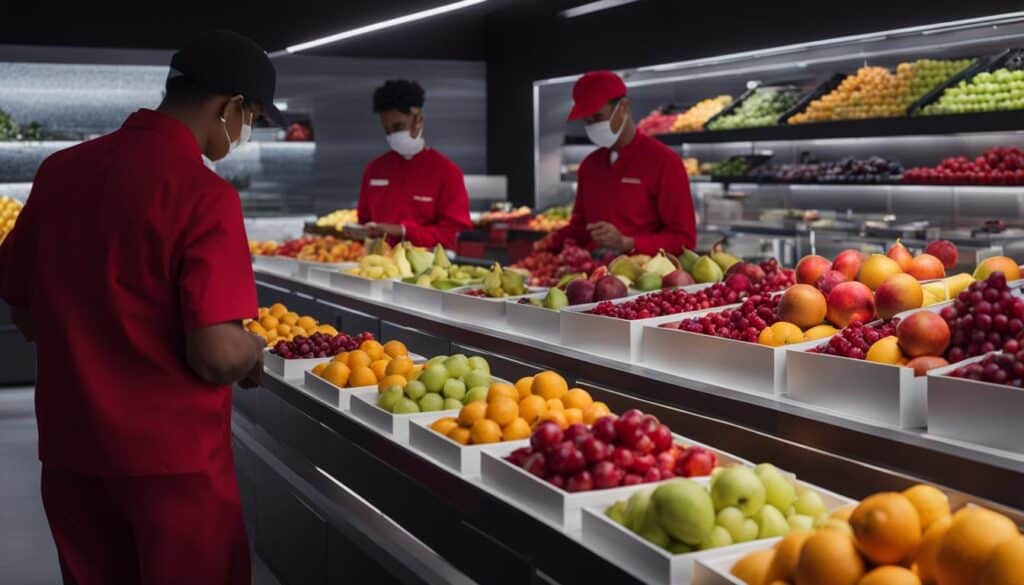
The focus in the luxury fruit market is firmly on quality over quantity. Each individual fruit undergoes meticulous scrutiny to ensure it meets the highest standards of appearance and taste. This attention to detail is what sets luxury fruits apart and contributes to their hefty price tags.
It’s important to note that luxury fruits in Japan are primarily intended as gifts, rather than for everyday consumption. These exquisite offerings are often presented for special occasions, corporate gifts, or to demonstrate appreciation and respect. By presenting luxury fruits, one can effortlessly convey a sense of prestige and thoughtfulness.
Exquisite Flavors and Varieties
One of the most remarkable aspects of the luxury fruit market in Japan is the wide array of flavors and varieties available. From juicy, perfectly ripe peaches to succulent, seedless grapes, there is a fruit to suit every discerning palate.
“Japanese luxury fruits are like edible jewels, each bursting with extraordinary flavors that can transport you to gastronomic bliss.”
The cultivation techniques employed in Japan result in fruit with unparalleled sweetness, tenderness, and juiciness. The fruits are carefully nurtured, often grown in climate-controlled environments and pampered with the utmost care.
Exploring the Mysterious World of Luxury Fruits
If you find yourself enchanted by the allure of luxury fruits, there are several avenues to explore and immerse yourself in this fascinating world. High-end department store food halls, specialty fruit shops, and online retailers offer a glimpse into the extravagant realm of luxury fruits.
Visiting places like Nishimura Fruits Parlor and the basement food hall of Tokyu Department Store allows you to witness the grandeur and artistry associated with luxury fruits. These establishments curate the finest selection of fruits, showcasing their exquisite beauty and unmatched quality.
By experiencing the luxury fruit market in Japan firsthand, you not only gain an appreciation for the level of craftsmanship that goes into producing these fruits but also for the cultural significance they hold in Japanese society.
| Key Features of the Luxury Fruit Market in Japan | Benefits of Experiencing the Luxury Fruit Market |
|---|---|
| Elaborate packaging reminiscent of jewelry boxes | Opportunity to indulge in unparalleled flavors |
| Meticulous attention to appearance and taste | Understanding the cultural significance of luxury fruits |
| Primarily intended for gifting purposes | Discovering the grandeur and artistry associated with luxury fruits |
The Cultivation of Luxury Fruits in Japan
Fruit cultivation in Japan is a fascinating and intricate process that combines traditional techniques with modern innovation. Local fruit farmers in Japan are dedicated to the art of growing premium fruits, constantly striving to create new and improved varieties. The meticulous cultivation practices employed by these farmers contribute to the exceptional quality and unique flavors of Japanese fruits.
In order to ensure that each fruit meets the highest standards, farmers in Japan practice careful pruning and hand pollination. This hands-on approach allows them to carefully monitor and control the growth of each fruit, resulting in fruits that are perfectly shaped and free from imperfections. By concentrating nutrients in each fruit, farmers are able to enhance the flavor and sweetness, creating a truly delightful eating experience.
One of the distinctive cultivation techniques employed by Japanese fruit farmers is the practice of growing only one fruit per branch. This method, known as “one fruit, one branch,” allows each fruit to receive maximum nutrients and attention, resulting in larger, juicier, and more flavorful fruits. Although this approach requires more time and effort, it is the key to producing luxury fruits that command premium prices in the market.
| Advantages of Japanese Fruit Cultivation | Disadvantages of Japanese Fruit Cultivation |
|---|---|
| Exceptional fruit flavor and sweetness | Labour-intensive process |
| A wide variety of unique fruit breeds | Limited availability and higher costs |
| Perfectly shaped and blemish-free fruits | Strict regulations and standards |
“Japanese fruit farmers are dedicated to the pursuit of perfection, and their meticulous cultivation practices are evident in the exceptional quality of their fruits.”
These cultivation methods, combined with the unique climate and fertile soil of Japan, result in fruits that are simply unparalleled in terms of taste, texture, and appearance. The commitment and passion of Japanese fruit farmers shine through in the incredible fruits they produce.
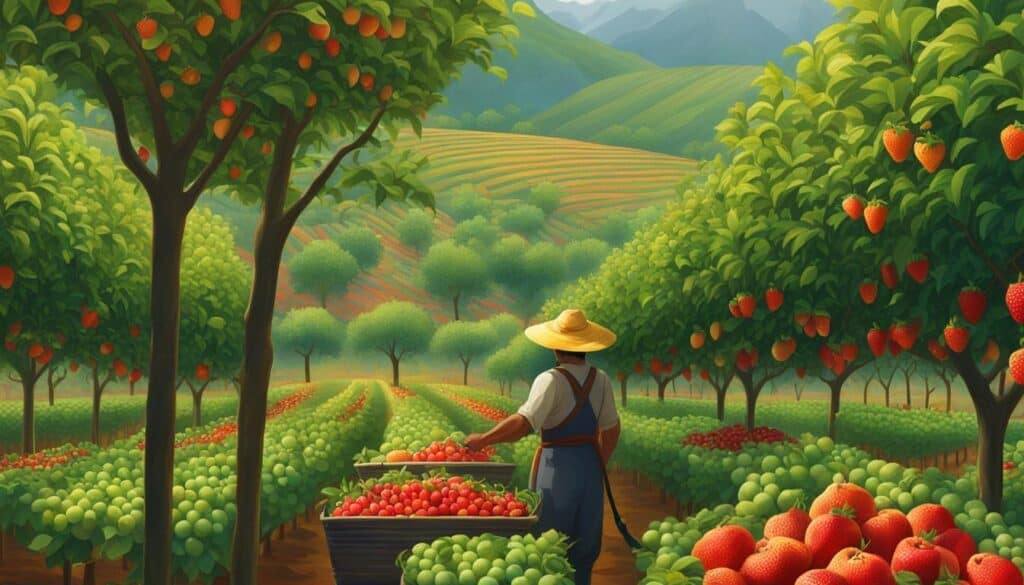
Next, let’s explore the significance of fruits in Japanese rituals and traditions in the following section.
The Significance of Fruit in Japanese Rituals and Traditions
Fruit holds great historical and cultural significance in Japan. It has been offered as a gift since ancient times and plays a prominent role in religious rituals, particularly in Shinto and Buddhist traditions. Fruit is seen as a valuable offering to honor ancestors and deities, symbolizing gratitude and respect.
“Fruit is not just a gift, but a symbol of appreciation and respect in Japanese culture. It carries with it a sense of value and reverence.”
The tradition of offering fruit has deep roots in Japan. It is believed that the gods and spirits enjoy the sweet taste and vibrant colors of fruit offered to them. In Shinto shrines, fruit is presented as an offering during ceremonies and festivals, symbolizing purity and abundance. Buddhist temples also incorporate fruit offerings as a way to express devotion and seek blessings.
The cultural significance of fruit extends beyond religious contexts. Fruit has historically been used as a token of appreciation and respect for leaders in Japanese society. One example of this tradition is the offering of fruits by samurais to their shoguns, symbolizing loyalty and honor.
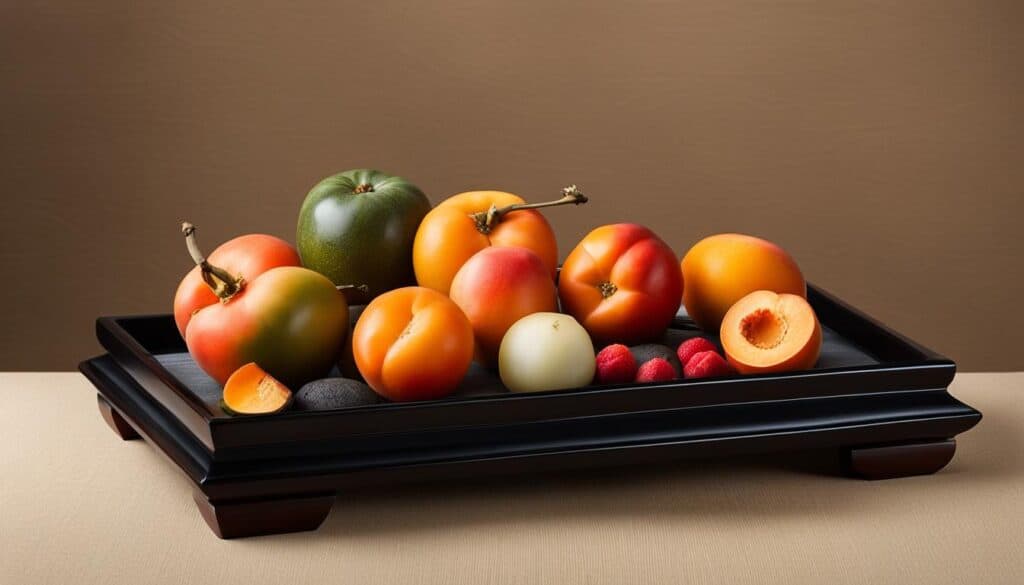
“The gifting of fruit is a way to demonstrate respect and gratitude, reflecting the deep-rooted values of Japanese society.”
In addition to its symbolic value, fruit also represents luxury and abundance in Japanese culture. Offering exquisite and flawlessly presented fruits is a way to showcase one’s social status and appreciation for the recipient.
The Importance of Fruit in Japanese Tea Ceremonies
Japanese tea ceremonies, known as “chanoyu” or “sado,” also incorporate the use of fruit as a significant element. Fruits like persimmons and yuzu are often served alongside traditional Japanese sweets during tea ceremonies. These fruits not only enhance the aesthetic appeal of the tea ceremony but also provide a refreshing balance to the bitterness of the tea.
Overall, fruit holds a central place in Japanese rituals and traditions, serving as a symbol of respect, gratitude, and abundance. Its cultural significance, combined with meticulous cultivation practices and high prices, further adds to the luxury status of fruit in Japan.
| Ritual/Tradition | Significance |
|---|---|
| Shinto Shrines | Purity, abundance, and offering to gods |
| Buddhist Temples | Devotion and seeking blessings |
| Offering to Leaders | Respect, loyalty, and honor |
| Tea Ceremonies | Aesthetic appeal and balance |
Buying Affordable Fruit in Japan
While luxury fruits may dominate the market in Japan, there are ways to find affordable fruit. Shopping in rural regions, visiting local farmers’ markets, or buying directly from farmers can offer cheaper options. Seasonal fruits from the countryside can be more affordable due to lower transportation costs. Supermarkets and convenience stores also offer everyday fruit options at more reasonable prices. Shopping with the seasons and opting for local varieties can help keep fruit costs down.
| Options for Buying Affordable Fruit in Japan | Pros | Cons |
|---|---|---|
| Shopping in rural regions | – Lower prices due to reduced transportation costs – Fresh, locally grown options | – Limited selection compared to urban areas – Accessibility may be an issue for some |
| Visiting local farmers’ markets | – Directly supporting local farmers – Wide variety of seasonal fruits | – Prices may not be as low as rural regions – Limited availability depending on market days |
| Buying directly from farmers | – Lowest prices as there are no middlemen involved – Personal interaction with farmers | – Limited to specific farms and locations – May require advanced planning and coordination |
| Shopping at supermarkets and convenience stores | – Convenient accessibility – Wide variety of fruit options | – Prices may still be higher compared to rural areas – Limited availability of locally grown fruits |
By exploring these options, you can find affordable fruit in Japan without compromising on quality or taste. Shopping smart and taking advantage of seasonal and local produce can help you enjoy a wide variety of fruits while sticking to your budget.
Experiencing the Luxury Fruit Market in Japan
If you’re eager to delve into the world of luxury fruits in Japan, a visit to department store food halls and specialty fruit shops is a must. These establishments showcase a dedicated section filled with a stunning array of luxury fruits, ranging from mouthwatering melons to luscious grapes. The experience immerses you in the opulence and variety of Japan’s luxury fruit market.
One of the highly recommended places to explore is the renowned Nishimura Fruits Parlor. Located in Tokyo, this exquisite fruit parlor offers an unrivaled selection of vibrant and flavorful luxury fruits. From meticulously cultivated strawberries to perfectly shaped peaches, each fruit is a work of art. Indulge your senses as you savor the exceptional quality and taste of these premium fruits.
For another captivating luxury fruit experience, venture into the basement food hall of the Tokyu Department Store. This bustling marketplace is a treasure trove of gourmet delights, featuring an impressive display of luxury fruits. Admire the meticulous presentation of golden-hued pineapples, juicy cherries with flawless skin, and ruby-red apples that exude elegance. It’s a feast for the eyes and a temptation for the taste buds.
Exploring these luxury fruit destinations is an opportunity to witness firsthand the exceptional care and craftsmanship that goes into nurturing these extraordinary fruits. The attention to detail in both cultivation and presentation truly embodies the unique culture and appreciation for premium produce in Japan.
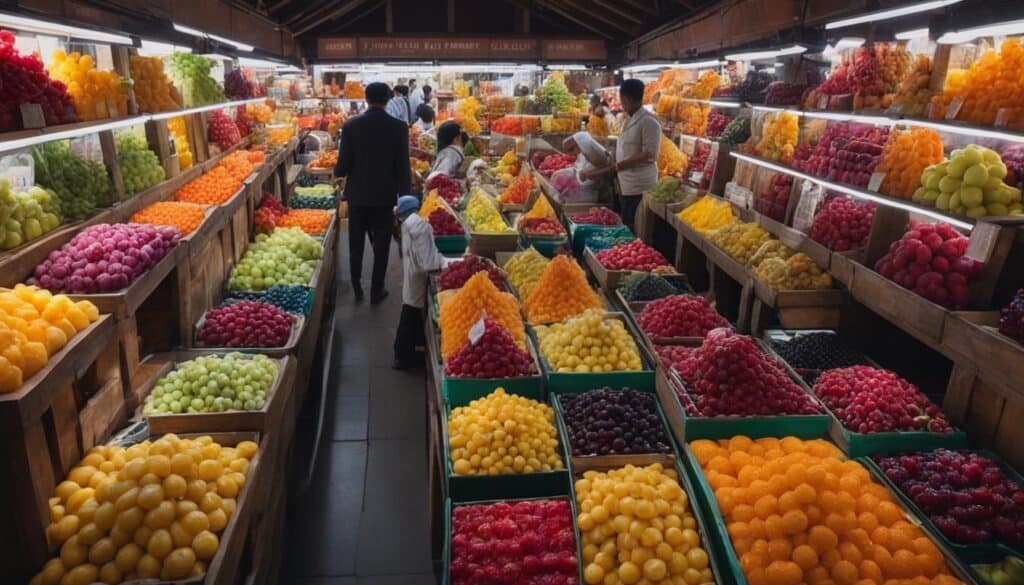
The image above provides a glimpse of the stunning variety of luxury fruits available in Japan. The meticulous cultivation techniques and captivating presentation make these fruits coveted items in the luxury fruit market.
Conclusion
Fruit in Japan holds a special place in the culture, with a focus on gifting and premium quality. The high prices of luxury fruits reflect the meticulous cultivation processes, limited availability, and cultural significance. Japanese fruit, such as melons and grapes, is not just a snack but a luxury item that is often given as a gift.
While the cost of fruit in Japan may be higher compared to other countries, there are still affordable options available, especially when shopping in rural regions or during specific seasons. Visiting local farmers’ markets or buying directly from farmers can offer cheaper alternatives. Seasonal fruits from the countryside can also be more affordable due to lower transportation costs.
Experiencing the luxury fruit market in Japan can provide a deeper understanding of the country’s unique appreciation for exquisite produce. Department store food halls and specialty fruit shops are worth a visit to witness the exquisite presentation and variety available. Nishimura Fruits Parlor and the basement food hall of Tokyu Department Store are recommended places to explore the luxury fruit market.
FAQ
Is fruit expensive in Japan?
Yes, fruit in Japan is often seen as expensive compared to other countries. Japanese fruit, such as melons and grapes, is not just a snack but a luxury item.
Why is fruit so expensive in Japan?
The high prices of fruit in Japan can be attributed to factors such as regulations on size and taste, limited fruit crops due to mountainous terrain, and meticulous cultivation practices.
What role does fruit play in Japanese culture?
Fruit holds a special place in Japanese culture and is often given as a gift, served at the end of high-end meals, and plays a role in religious rituals and traditions.
Where can I find affordable fruit in Japan?
Shopping in rural regions, visiting local farmers’ markets, or buying directly from farmers can offer cheaper options. Supermarkets and convenience stores also offer everyday fruit at more reasonable prices.
How can I experience the luxury fruit market in Japan?
Department store food halls and specialty fruit shops are worth a visit to experience the luxury fruit market in Japan. They showcase the exquisite presentations and variety of luxury fruits available.

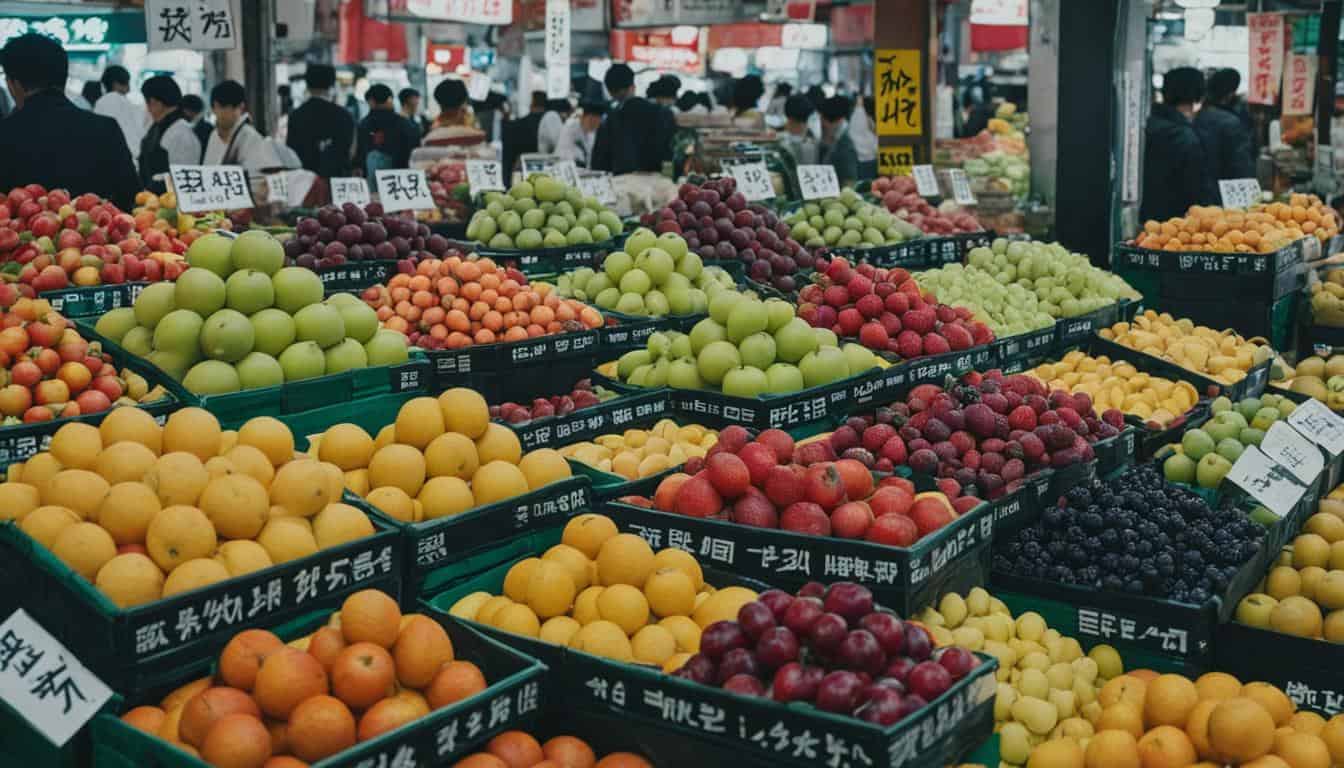



Leave a Reply